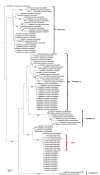Oropouche Fever, Cuba, May 2024
- PMID: 39255237
- PMCID: PMC11431908
- DOI: 10.3201/eid3010.240900
Oropouche Fever, Cuba, May 2024
Abstract
Phylogenetic analyses showed that the virus responsible for a May 2024 Oropouche fever outbreak in Cuba was closely related to viruses from Brazil in 2023. Pools of Ceratopogonidae spp. biting midges and Culex quinquefasciatus mosquitoes were positive for Oropouche viral RNA. No cases were severe. Virus extension to new areas may increase case numbers and severity.
Keywords: Cuba; Oropouche virus; arboviruses; orthobunyavirus; vector-borne infections; viruses.
Figures


References
-
- Pan American Health Organization/World Health Organization. Alerta Epidemiológica: oropouche en la región de las Américas, 9 de mayo del 2024. [cited 2024 May 12]. https://www.paho.org/es/documentos/alerta-epidemiologica-oropouche-regio...
Publication types
MeSH terms
Substances
Supplementary concepts
LinkOut - more resources
Full Text Sources
Miscellaneous

